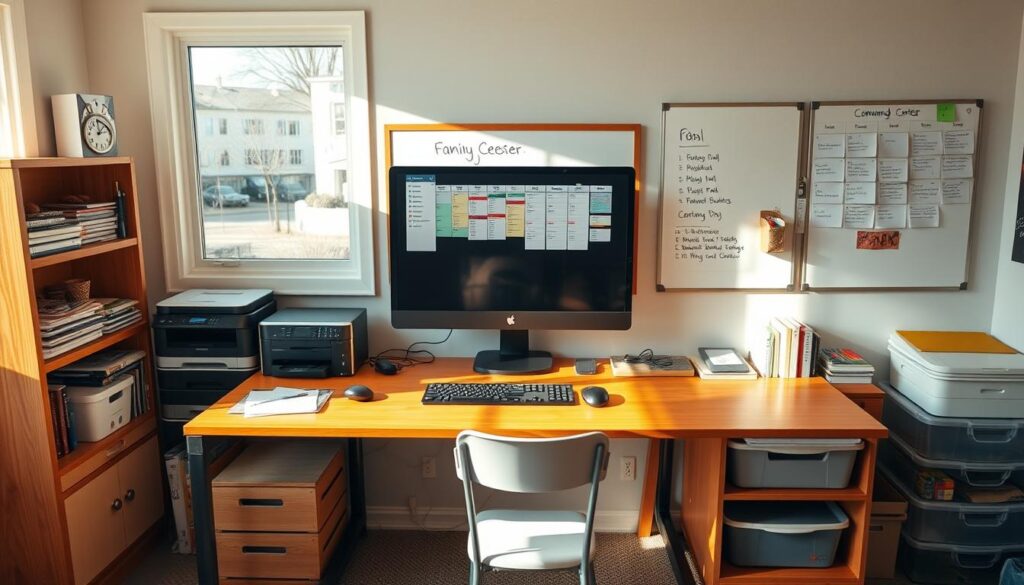Imagine running your household as smoothly as NASA manages a rocket launch. Just like mission control relies on real-time data and teamwork, families can benefit from a centralized system to track schedules, chores, and important tasks. This concept isn’t new—hospitals and emergency rooms use similar strategies to coordinate care. Why not apply these organizational principles at home?
A dedicated space for managing daily life helps reduce chaos. Think of it as your family’s mission hub: a spot where calendars, reminders, and to-do lists live in harmony. No more missed soccer practices or forgotten grocery runs. Everything stays visible and accessible, giving everyone a clear roadmap for the week.
Setting up this system doesn’t require fancy tools or hours of work. Start with a wall calendar, a bulletin board, or even a digital app. The goal is simplicity. Busy parents and kids can quickly check schedules, add updates, or grab permission slips on the go.
In this guide, you’ll learn how to create a stress-free zone that works for your family’s unique rhythm. From choosing the right tools to maintaining momentum, we’ll walk you through each step with practical tips and encouragement.
Key Takeaways
- Centralized organization reduces stress by keeping schedules and tasks in one visible spot
- Simple tools like calendars or apps can create an effective family management system
- Adapt strategies from professional settings like hospitals or NASA for home use
- Customizable setups ensure the system grows with your family’s needs
- Consistent updates and teamwork keep the process running smoothly
Planning Your Home Command Center
Every household operates like a mini universe with its own rhythms and requirements. Before building your family’s organizational hub, pause to observe how your crew actually functions day-to-day. Do permission slips vanish into backpacks? Does dinner prep collide with homework time? These pain points reveal where your system needs the most support.
Assessing Your Family’s Organizational Needs
Start by tracking your weekly routines for three days. Note where things flow smoothly and where chaos erupts. A family with teens might need digital reminders for sports practices, while younger kids could benefit from visual chore charts. Consider these factors:
- High-traffic areas where information gets seen (kitchen walls vs. smartphone alerts)
- Time-sensitive tasks requiring immediate attention
- Preferred communication styles (sticky notes vs. group texts)
Setting Clear Priorities and Goals
Identify your non-negotiables first. For many families, meal planning and school schedules top the list. One parent shared: “We color-code activities by family member—it’s cut arguments about who needs the car by 80%.” Try these strategies:
- Schedule 15 minutes weekly to update systems together
- Use budget-friendly tools like whiteboard calendars
- Rotate responsibility for maintaining the space
Remember, your setup should evolve as kids grow or schedules change. What works during soccer season might need tweaking when summer arrives. The key is creating a flexible foundation rather than a perfect system.
Designing a Functional Space for Efficiency
Transform chaos into clarity by borrowing smart design ideas from professional operations. Your family’s management hub should act like a well-oiled machine—visible, intuitive, and ready for action.
Choosing the Ideal Location in Your Home
Start by identifying high-traffic zones where people naturally gather. Kitchen walls near breakfast areas or entryway nooks work well. Look for spots with:
- Ample natural light to reduce eye strain
- Minimal visual distractions from TVs or play areas
- Easy access to charging outlets for devices
One parent transformed their laundry room wall into a planning powerhouse using these design principles. “We check schedules while folding clothes—it’s become our secret weapon,” they shared.
Selecting Tools, Calendars, and Storage Solutions
Mix analog and digital tools based on your family’s habits. A magnetic weekly calendar paired with a shared notes app covers most needs. Consider these essentials:
- Dry-erase boards for quick reminders
- Wall pockets for permission slips and mail
- Color-coded bins for school supplies
Keep displays simple—limit each surface to three key items. Rotate seasonal tools like sports schedules or holiday planners. Remember: less clutter means better focus on what matters most.
Step-by-Step Setup Process
Think of building your family hub like assembling a puzzle—each piece matters, but you don’t need all answers upfront. Start by clearing a 4×4 foot wall area. This becomes your blank canvas for creating order.

Gathering Resources and Getting Started
First, collect these essentials:
- Magnetic calendar (size depends on family size)
- Wall-mounted file pockets for paperwork
- Dry-erase markers and decorative magnets
One parent told us: “We repurposed an old baking sheet as our magnetic board—saved $40!” Lay tools on the floor to test layouts before mounting. Leave breathing room between sections to prevent visual overload.
Implementing a Daily Routine
Designate specific times for updates. Mornings work best for checking schedules, while evenings suit planning tomorrow’s tasks. Try this sequence:
- Review calendar during breakfast
- Drop permission slips in labeled pockets before leaving
- Update chore charts after dinner
Avoid these common mistakes: overcrowding the space or using tiny fonts. If something isn’t working after three days, rearrange it. Consistency turns this setup into second nature—like brushing teeth—for lasting family habits.
Implementing a Command Center System
Hospitals blend digital charts with whiteboards to track patient care—a strategy that works wonders for busy families too. Your home management hub thrives when paper and tech work together. This hybrid approach ensures no detail slips through cracks, whether you’re packing lunches or prepping for parent-teacher conferences.

Blending Digital and Physical Tools
Start by pairing a shared Google Calendar with a large wall calendar. Color-code events by family member using matching sticky notes and digital labels. Sync reminders across devices so everyone receives alerts two hours before practice or meetings.
Try these combinations:
- Magnetic grocery lists + voice-activated shopping apps
- Printed weekly menus + recipe bookmark folders
- Chore charts with moveable magnets + reward-tracking apps
| Tool Type | Best For | Popular Options |
|---|---|---|
| Digital | Instant updates, reminders | Cozi, Trello, Alexa |
| Paper | Visual learners, quick notes | Whiteboards, chalkboard paint |
| Hybrid | Sync across devices | Rocketbook, Smart Planner |
One mom shared: “We use a Rocketbook that scans notes to our phones—game changer for permission slips!” Set weekly sync sessions where everyone reviews both systems. Delete outdated digital alerts and refresh physical displays.
Keep chargers near your hub so devices stay ready. Rotate which family member updates the wall calendar each week. This teamwork approach builds responsibility while keeping your system current.
Maintaining and Adapting Your Command Center
Your family hub thrives when treated like a living system—not a static display. Modern operations centers from hospitals to tech startups schedule weekly tune-ups, and your home deserves the same care. A quick refresh keeps calendars accurate and prevents clutter from creeping back.
Regular Updates and System Reviews
Set recurring reminders to purge outdated papers and digital alerts. One parent shared: “We do a five-minute sweep every Sunday—old permission slips go, new meal plans arrive.” Try these maintenance habits:
- Update emergency contacts quarterly using checklist strategies
- Rotate chore charts monthly to match school schedules
- Swap seasonal tools like summer camp lists for holiday gift trackers
Involve kids by letting them choose new magnet designs or app themes. Families using shared responsibility models report 30% better consistency. Hold monthly “family meetings” to discuss what’s working—and what needs tweaking.
Flexible storage solutions make adjustments painless. Use removable hooks for backpacks or modular bins that shift with growing needs. When unexpected events hit, your system bends instead of breaking. That’s the real power of an adaptable organization strategy.
Conclusion
Just like a well-coordinated team needs a playbook, families thrive with a centralized hub for managing daily life. The strategies we’ve explored—from planning layouts to blending tech tools—prove organization doesn’t require perfection. Start with a wall calendar and expand as needs grow, borrowing ideas from hospitals and NASA’s proven systems.
Successful setups share three traits: visibility, flexibility, and teamwork. Color-coded schedules reduce missed events, while rotating responsibilities keep everyone invested. Remember how emergency rooms update boards hourly? Apply that “refresh mindset” with weekly five-minute check-ins.
Your home’s rhythm will change—and so should your system. Maybe swap paper menus for digital apps as kids age, or add charging stations for teen devices. What matters is creating a space where permission slips don’t vanish and pizza nights get planned effortlessly.
Ready to transform chaos into clarity? Grab a whiteboard or download a shared app today. Small steps build lasting habits, turning daily scrambles into smooth routines. When everyone knows the game plan, you’ll spend less time coordinating and more time connecting.

